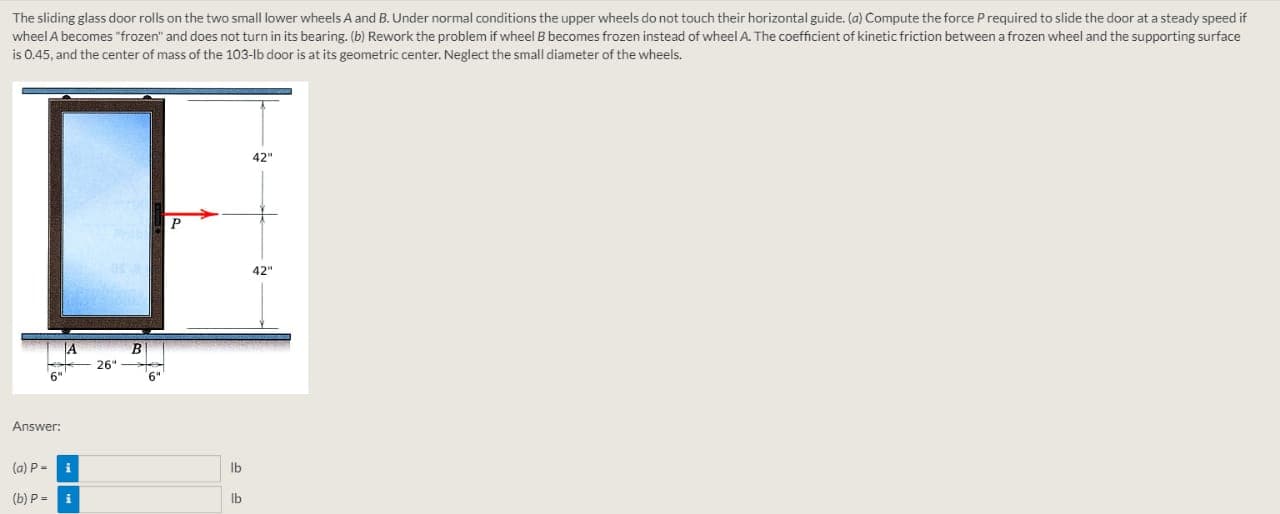The sliding glass door rolls on the two small lower wheels A and B. Under normal conditions the upper wheels do not touch their horizontal guide. (a) Compute the force P required to slide the door at a steady speed if wheel A becomes "frozen" and does not turn in its bearing. (b) Rework the problem if wheel B becomes frozen instead of wheel A. The coefficient of kinetic friction between a frozen wheel and the supporting surface is 0.45, and the center of mass of the 103-lb door is at its geometric center. Neglect the small diameter of the wheels. 42" P 42" A B 26 6" Answer: (a) P= Ib (b) P = i Ib
The sliding glass door rolls on the two small lower wheels A and B. Under normal conditions the upper wheels do not touch their horizontal guide. (a) Compute the force P required to slide the door at a steady speed if wheel A becomes "frozen" and does not turn in its bearing. (b) Rework the problem if wheel B becomes frozen instead of wheel A. The coefficient of kinetic friction between a frozen wheel and the supporting surface is 0.45, and the center of mass of the 103-lb door is at its geometric center. Neglect the small diameter of the wheels. 42" P 42" A B 26 6" Answer: (a) P= Ib (b) P = i Ib
International Edition---engineering Mechanics: Statics, 4th Edition
4th Edition
ISBN:9781305501607
Author:Andrew Pytel And Jaan Kiusalaas
Publisher:Andrew Pytel And Jaan Kiusalaas
Chapter7: Dry Friction
Section: Chapter Questions
Problem 7.72P
Related questions
Question

Transcribed Image Text:The sliding glass door rolls on the two small lower wheels A and B. Under normal conditions the upper wheels do not touch their horizontal guide. (a) Compute the force P required to slide the door at a steady speed if
wheel A becomes "frozen" and does not turn in its bearing. (b) Rework the problem if wheel B becomes frozen instead of wheel A. The coefficient of kinetic friction between a frozen wheel and the supporting surface
is 0.45, and the center of mass of the 103-lb door is at its geometric center. Neglect the small diameter of the wheels.
42"
P
42"
A
B
26
6"
Answer:
(a) P=
Ib
(b) P = i
Ib
Expert Solution
This question has been solved!
Explore an expertly crafted, step-by-step solution for a thorough understanding of key concepts.
This is a popular solution!
Trending now
This is a popular solution!
Step by step
Solved in 3 steps with 3 images

Knowledge Booster
Learn more about
Need a deep-dive on the concept behind this application? Look no further. Learn more about this topic, mechanical-engineering and related others by exploring similar questions and additional content below.Recommended textbooks for you

International Edition---engineering Mechanics: St…
Mechanical Engineering
ISBN:
9781305501607
Author:
Andrew Pytel And Jaan Kiusalaas
Publisher:
CENGAGE L

International Edition---engineering Mechanics: St…
Mechanical Engineering
ISBN:
9781305501607
Author:
Andrew Pytel And Jaan Kiusalaas
Publisher:
CENGAGE L